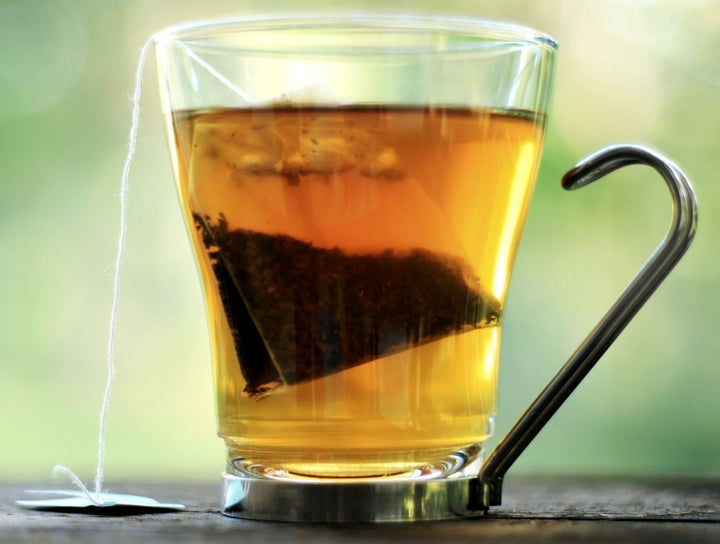As you cook, store food and even brew your morning coffee or tea, you may be inadvertently adding microplastics to your food and drinks. These tiny plastic particles are increasingly showing up not only in our food but also in our bodies (Heads up: they’ve been found throughout the body, from the brain to the blood, liver and placenta).
A big way microplastics get into our food is through contaminated soil, water and air. But it can also happen right in the kitchen, through simple daily habits that you likely have a lot of control over. Whether you’re chopping veggies on a plastic cutting board or reheating last night’s dinner in a plastic container, you may be increasing your exposure to microplastics.
As of now, a lot more research is needed to get a better understanding of how microplastics and nanoplastics might directly affect or harm human health. But some early research results allow us to see that the potential health consequences may not be great. For example, research findings from one observational study show that microplastics found in arteries may potentially increase the risk of having a stroke and heart disease.
If you’re concerned about your microplastic exposure — and how your kitchen habits may be playing a role — we have some good news. In most cases, you can lean into some simple, plastic-free swaps.
Here are six ways microplastics might be making their way into your food and drinks due to your kitchen habits, and what you can use instead.
1. Plastic Cutting Boards
Many people rely on plastic cutting boards because they’re nonporous and can be easier to clean. But this may not be the best idea. When you cut food on a plastic cutting board, you’re often putting microplastics directly into your food. And research shows that the stronger the cut, the more microplastics are released.
“Plastic cutting boards are one of the biggest exposure rates and one of the easiest things to switch out,” said Jennifer Brandon, a microplastics expert, oceanographer and founder of Wild Beacon Consulting.
In a study published in the journal Environmental Science & Technology, researchers found that people may be exposed to up to 50 grams of microplastics each year from using plastic chopping boards in the kitchen. “For reference, a credit card is five grams, so that’s a lot of plastic,” Brandon said.
What can you use instead?
Consider using a wood or bamboo cutting board.
Mint Images via Getty Images
2. Heating Food In Plastic Storage Containers
If much of your meal prep involves reheating food in plastic containers, you may want to change your ways. When many plastic storage containers are heated, microplastics can leach into your food. Plastic containers that are safe to use in the microwave are typically labeled “microwave safe,” according to the U.S. Department of Agriculture. But take-out containers, yogurt containers, margarine tubs and other containers designed for one-time use should not be used in the microwave, they say. Still, many experts have cautioned against heating food in plastic containers, even if they’re labeled microwave safe.
“There was a study that heated a plastic food container with just water in it, and they found more than 10 million microplastics that were leached into the water that was in that container,” said Victoria Fulfer, a postdoctoral fellow at the University of Rhode Island and researcher specializing in microplastic pollution at the 5 Gyres Institute.
Heating bags of frozen vegetables right in their plastic packaging isn’t the greatest idea, either. Similar to microwave-safe plastic containers, packages of vegetables labeled as microwave safe should be fine to use. But there’s not a lot of research available on this, and many experts advise against heating food in plastic. “When you’re heating them up, it’s causing the bonds in the plastic to break, and that allows microplastics and nanoplastics and also those chemicals in the plastic to get directly into your food,” Fulfer said. “And that can be a big problem because those are really small particles.”
A recent class-action lawsuit against Ziploc’s parent company alleges that the company’s “microwave safe” marketing claims are misleading due to the potential for releasing microplastics when heated — however, the company maintains that the products are safe.
What can you use instead?
Swap out your plastic storage containers for oven or microwave-safe glass containers. These do not leach microplastics or chemicals into your food and are generally more durable.
And rather than heating plastic veggies directly in their plastic packaging, transfer them to a glass container to heat them in the microwave or to a pan for heating on the stove.
3. Using Disposable Plastic Storage Bags
Do you tend to store your snacks and leftovers in plastic storage bags? If so, it may be time to find an alternative. “These plastics are soft, so they shed plastic flakes easily, which can become a considerable health risk for those that often use these types of bags,” said Bryan Quoc Le, food scientist and food industry consultant.
In a 2020 study published in Scientific Reports, researchers found that simply opening plastic packaging — whether through snipping with scissors, tearing a bag, twisting or cutting with a knife — can generate microplastics. The amount generated varied depending on the thickness of the plastic packaging, but the researchers noted that this sends a warning about the importance of using care when opening plastic packaging for those who are concerned about microplastics.
What can you use instead?
Use reusable silicone bags, stainless steel or glass containers or beeswax wraps.

Lori Lee Miller via Getty Images
4. Using Plastic Wrap Against Hot Food
Plastic wrap can release plastic particles into food, “especially when placed directly against hot food, since it is such a soft plastic,” Le said. “Depending on factors such as the temperature and moisture of the food, this could pose serious problems because some of the plastic wrap could actually melt onto the food, which would become a major hazard.”
What can you use instead?
Cover your food loosely with aluminum foil (but do not put this in the microwave), or use reusable silicone stretch wraps, beeswax wraps or a glass container with a lid.
5. Cooking With Plastic Utensils
Do you still cook with plastic utensils? Research shows that these release substantial amounts of microplastic particles with normal use, which can then be ingested with food. When heated, this is an even bigger problem.
“As we use them on our hot pans — you’ve probably noticed if you use them at home — they start to melt a little, and plastic will come off of them,” Fulfer said.
What can you use instead?
Ditch your plastic cooking utensils and switch to products made of wood or metal, depending on what type of pan you’re cooking with.
6. Using Plastic Tea Bags
Many tea bags are made of a type of plastic called polypropylene. When you brew these tea bags in water that’s been heated to a high temperature, the bag can begin to break down and release microplastics. Others made of nylon and cellulose have also been found to release microplastics.
Researchers in Spain and Canada, for example, found that plastic tea bags may release millions or even billions of microplastic particles when steeped in hot water.

Darla Winn, Photographer via Getty Images
“The danger of this is that these millions of microplastics and nanoplastics can enter the bloodstream and [gastrointestinal] tract, and can be quite small, and may be small enough to cross the blood/brain barrier, as we have seen with other nanoplastics,” Brandon said.
What can you use instead?
The safest option is to brew loose leaf tea in a glass or metal tea infuser or kettle. If you want to stick with tea bags, look for teas labeled as plastic free or those made of natural materials like 100% cotton, hemp or paper. If you go this route, keep in mind that while these shed fewer microplastics than those made of plastic, even paper tea bags are not always plastic-free.
Read the full article here








